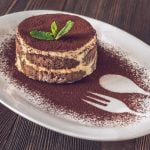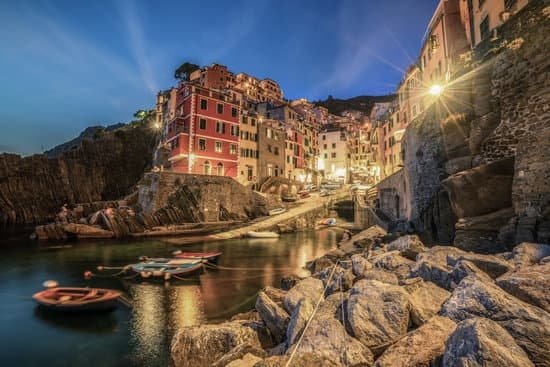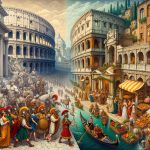
The influence of Italian culture is far-reaching and difficult to overstate. Famous Italian historical figures have been credited with some of the most fundamental developments of Western Civilization from the Renaissance to modern day.
From Michelangelo’s sculptures that grace many of the world’s greatest art galleries, to the first harnessed telescope designs by Galileo Galilei, innovations in food and literature by Leonardo Da Vinci, and so much more, it’s clear that Italians have left a remarkable contribution on humanity.
Notable achievements – Expand on particular, famous Italian historical figures that made important accomplishments One of the most famous Italian historical figures is Leonardo da Vinci, his brilliance stretched across multiple disciplines such as painting, sculpture, engineering and even music. He is best known for his magnificent masterpiece The Last Supper which can be seen in Milan Italy today.
His influence was so great it earned him an honorary title as “Renaissance Man” due to his multidimensional talents which helped revolutionize science and technology during the century thereafter. This all began with his groundbreaking invention of something as minor as a rudimentary parachute design to illustrate concepts useful in 17th century aviation leading up to use in war efforts during WWII.
Music composition – Expand on Italians contribution to music including composers or styles originating in Italy Opera was one of the outstanding musical contributions coming from famous Italian Historical Figures. Composers such as Gioachino Rossini or Giacomo Puccini wrote some of the world’s most beautiful operas that are still played all around Europe today.
For several centuries this style was considered a superior form of popular entertainment which further underlined its widespread popularity amongst people across social classes at the time. Other forms such as symphonic bands like La Grande Orchestra Napoli were essential part of traditional Italian folk culture after WWI responsible for rekindling appreciation for folk songs into mainstream pop culture throughout Europe and parts of North America later into 20th century.
Overview of Ancient Italian Figures
Alexander The Great was a Macedonian general, statesman, and one of the most successful military commanders in history. He conquered many lands in Europe and South Asia during his lifetime. He is known for founding the multicultural city of Alexandria, Egypt. His tactical skill and resourcefulness enabled him to lead highly successful campaigns against enemies who were outnumbering him significantly. After his death, he became a source of inspiration throughout empire’s centuries, symbolising military prowess and intellectual brilliance.
Nero was the last of Julius Caesar’s adoptive heirs, ruling from 54 AD until 68 AD when he committed suicide after several failed attempts to crush revolts in Roman provinces. Nero has been remembered as one of Rome’s most influential leaders due to his involvement in the development of Roman architecture, literature, and music culture during his rule.
He also oversaw a number of major building projects including the Imperial Palace on Piazza Navona which is still considered one of Rome’s architectural masterpieces today. Additionally, Nero strongly opposed religious persecution often allocating financial resources to rebuilding Jewish temples destroyed by Roman troops.
To summarise some Ancient Italian Figures:
- Alexander The Great – Alexander was a Macedonian general who conquered European and South Asian countries during his lifetime.
- Nero – Nero was remembered for influencing Roman architecture, literature and music culture as well as rebuilding Jewish temples destroyed by Roman troops.
Roman Empires Impact on Italy
Language has always been important in Italy. From its first settlement along the coast of Liguria, the language of Latin was used to communicate and organise campaigns. With the support of neighbouring cities such as Etruscan’s and Greeks, the Romans pushed their language further inland, making Latin a common language throughout Italy.
When the Roman Empire became highly successful, they brought with them a whole new level of knowledge and sophistication which had an enormous impact on education within Italy. Written texts were compiled with support from Roman law makers, forming part of a tradition which later evolved to incorporate classical literature.
This provided a comprehensive structure for learning which included focusing not only on reading text but also on philosophy and rhetoric topics which would form much of Italian culture moving forward.
The Romans also made their mark on Italian art. When Rome was built upon seven hills, it was filled with temples celebrating Rome’s gods and goddesses. Etruscan temples were also built out of marble creating beautiful structures around the city like the Colosseum where plays could be performed in honour to gods or events celebrated could be held, allowing freshness, energy and creativity to be present at all times.
- The Romans brought Latin language throughout Italy
- Classical literature formed part of Romes education system
- Roman art created beautiful marble structures
Medieval Figures
Italy has been home to some of the most influential figures in history. It is no surprise that many of these people had a major influence on Italian literature. Take a look at some of the famous medieval figures and how they impacted Dante Alighieri’s writing.
One such figure was Giotto di Bondone, who was an artist and architect in the early 14th century. Born in Florence, Italy, his work focused on religious topics and he created several works for cathedrals in Assisi, Rome and Padua. His style was different from most others from the period, featuring more natural elements instead of complex lines.
As a painter, he popularized linear perspective techniques which was later used by other artists such as Michelangelo and Botticelli. What’s more, Giotto’s work also inspired many of Dante’s later verses including The Divine Comedy, thanks to his use of real life events as inspiration.
Another prominent figure from this time period was Saint Francis of Assisi. He was born into nobility in 1181 but dedicated his life to preaching about poverty and charity throughout Europe before retiring to Cortona-Italy where he eventually died.
Although not directly linked to literature or writing, his teachings left a profound impact on Dante Alighieri; specifically his thoughts on compassion towards nature had a clear influence on Purgatorio which is part of ‘The Divine Comedy’. Moreover, some critics believe there are references to Saint Francis throughout the poem although that hasn’t been completely confirmed yet.
In Summary
- Giotto di Bondone: Artist and architect during the early 14th century who developed linear perspective techniques which were copied by other artists like Michelangelo. Giotto’s work inspired Dante’s verse in The Divine Comedy.
- Saint Francis of Assisi: Noble turn saint who preached around Europe; Thoughts on nature brought about level of detail to Purgatorio in ‘The Divine Comedy’.
Renaissance Figures
Galileo Galilei had a tremendous impact on science, philosophy and the arts during the Renaissance period. Born in Pisa, Italy in 1564 Galileo researched solar system phenomena, he was the first to use a refracting telescope, wrote books on astronomy, developed theories of motion and gravity and helped define modern scientific thought. His work essentially laid the groundwork for Isaac Newton’s later development of calculus.
Galileo’s most notable contribution to the sciences during this period was his astronomical discoveries and contributions towards understanding the Copernican Model of a heliocentric universe. In 1609 he published his Sidereus Nuncius, or “Starry Message” which comprehensively described his observations of Jupiter and its satellites. This positioned him as one of the first scientists who used empirical observation drawn from direct experimental evidence to disprove Aristotle’s established geocentric universe model that placed Earth at its centre.
Galileo was not only an astronomer but also made significant contributions in physics such as specifying inertia and still being known among many today as “father of modern physics”. He postulated that inertia kept a moving object going even when no force acts upon it which is sometimes referred to as “Galileo’s law of inertia”.
He revolutionised physics by introducing math into its problem solving logic as demonstrated through his many experiments utilizing inclined planes called inclinometers to prove concepts such as friction effect between objects in motion thus paving way for today’s mathematical models used in physics research.
- He published Sidereus Nuncius or “Starry Message” describing observations on planetary systems.
- Proved Copernican Model being a heliocentric universe
- Initiated way for using mathematics in problem solving logic in physics
- Introduced concept of Inertia
- “Father of modern Physics”
Religious Leaders
Paragraph 1 The Catholic Church has had an indelible impact on Italian culture and history, influencing the political and spiritual lives of the Italian people for centuries. One of the most significant religious figures to have had an influence on Italian society was Pope Urban II in 1095.
His speech at Clermont in France is credited with starting the First Crusade, which saw a great influx of armies marching through Italy towards Jerusalem in Palestine. This had a dramatic impact on both religion and politics, many Italians joining in with the hope that it would bring them closer to God’s grace.
Paragraph 2 Another influential religious figure in Italian history was St Francis of Assisi. He founded the Franciscan Order in 1209, which promoted peace, love and unity among christians and non-christians alike. His teachings were widely adopted throughout Italy and other parts of Europe, as people sought to emulate his life of poverty and humility. He has since come to be recognized as one of the greatest Catholicsing saints in Italy’s history.
Paragraph 3 Lastly is Pope Pius IX who ruled during 1846-1878 while Rome was undergoing transformation into a unified kingdom. Despite being viewed as conservative by some, he made huge strides towards unifying various aspects of Medieval Catholicism during this time such as:
- Declaring Papal Infallibility
- Prosper Lyons Council
- Defining doctrines regarding Mary
- Introducing Vatican Councils.
Political Figures
The history of Italian politics and the challenges faced by women fighting for gender equality is intertwined with the achievements of some key feminists, including Lisa Bosia and Maria Montessori.
Lisa Bosia was a vocal advocate for women’s rights in Italy in the 1950s. She founded “Tavola delle Liberta”, an organization dedicated to increasing awareness about the civil rights available to Italian women.
Bosia attempted to bridge barriers between rural and urban women, as well as workers in both professions who were disadvantaged by reduced access to social services. Women’s suffrage was her signature campaign and she worked diligently with clergy and reformers to pass laws which enabled all women over 21 years to vote in 1959.
Maria Montessori was a scientist and educator who established one of the most famous education systems still in use today. A strong supporter of progressive education among both boys and girls, she opened schools all around Europe.
Montessori believed that early childhood education should focus on developing an individual’s self-discipline. One of her most important contributions to education was introducing standardized methodology for teaching math: she became instrumental in helping children acquire basic arithmetic skills, such as understanding numbers and shapes.
- Bosia fought for civil rights available to Italian women especially through her main goal – suffrage for all female citizens over 21 years.
- Montessori developed an educational system centered around developing children’s self-discipline through math, numbers and shapes.
- Most importantly, both figures had a common aim – they wanted young generations to become more aware of their capabilities regardless of their gender or background.
Conclusion
Italian historical figures have had a major influence on the world in many areas, from arts and sciences to politics and technology. In arts and culture, names like Giacomo Puccini, Michelangelo, and Leonardo da Vinci are some of the most renowned artists who have inspired audiences for centuries with their works of music, painting, sculpture, and architecture. Although they lived hundreds of years ago, their works still resonate today.
In science and exploration, Italian Renaissance thinkers such as Galileo Galilei pioneered scientific knowledge-including today’s model of heliocentric astronomy-and Christopher Columbus’s travels to the New World opened the eyes of many Europeans to new vistas beyond their traditional imaginations. These voyages also ushered in an era of European colonialism that would lead to a series of dramatic changes in societies around the world.
Finally, modern Italy owes much to political leaders such as Benito Mussolini and Silvio Berlusconi who led waves of nationalism and socio-economic reform that shaped the country’s development during the late 19th century into present day. Their leadership helped form a strong sense of national identity that continues to contribute to Italy’s unique character.
From music to modern politics, famous Italian historical figures have profoundly affected our societies in numerous ways throughout history – a testament to their creativity and dynamism. They continue to be an inspiration for millions around the world for generations after generations.




